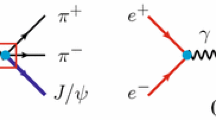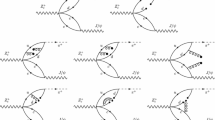Abstract
Very recently, the Belle and BESIII experiments observed a new charmonium-like state X(3823), which is a good candidate for the D-wave charmonium ψ(13 D 2). Because the X(3823) is just near the D \(\bar D*\) threshold, the decay X(3823)→ J/ψπ + π − can be a golden channel to test the significance of coupled-channel effects. In this work, this decay is considered including both the hidden-charm dipion and the usual quantum chromodynamics multipole expansion (QCDME) contributions. The partial decay width, the dipion invariant mass spectrum distribution dΓ[X(3823) → J/ψπ + π −]/dm π+π−, and the corresponding dΓ[X(3823) → J/ψπ + π −]/dcosθ distribution are computed. Many parameters are determined from existing experimental data, so the results depend mainly only on one unknown phase between the QCDME and hidden-charm dipion amplitudes.
Similar content being viewed by others
References
E. S. Swanson, The new heavy mesons: A status report, Phys. Rep. 429(5), 243 (2006)
S. L. Zhu, New hadron states, Int. J. Mod. Phys. E 17(02), 283 (2008)
N. Brambilla, S. Eidelman, B. K. Heltsley, R. Vogt, G. T. Bodwin, et al., Heavy quarkonium: Progress, puzzles, and opportunities, Eur. Phys. J. C 71(sn2), 1534 (2011)
X. Liu, An overview of XYZ new particles, Chin. Sci. Bull. 59(29-30), 3815 (2014)
S. L. Olsen, A new hadron spectroscopy, Front. Phys. 10(sn2), 101401 (2015)
C. Z. Yuan, Study of the XYZ states at the BESIII, Front. Phys. 10(6), 101401 (2015)
K. A. Olive, et al. (Particle Data Group), The review of particle physics, Chin. Phys. C 38, 090001 (2014)
S. Godfrey and N. Isgur, Mesons in a relativized quark model with chromodynamics, Phys. Rev. D 32(1), 189 (1985)
E. Eichten, K. Gottfried, T. Kinoshita, K. D. Lane, and T. M. Yan, Charmonium: The model, Phys. Rev. D 17(sn11), 3090 (1978) [Erratum: Phys. Rev. D 21, 313 (1980)]
L. Antoniazzi, et al. (The E705 Collaboration), Search for hidden charm states decaying into J/ψ or ψ′ plus pions, Phys. Rev. D 50(sn7), 4258 (1994)
V. Bhardwaj, et al. (The Belle Collaboration), Evidence of a new narrow resonance decaying to χc1γ in B → χc1γK, Phys. Rev. Lett. 111(sn3), 032001 (2013)
M. Ablikim, et al. (The BESIII Collaboration), Observation of the ψ(13D2) State in e+e− → π + π −γχc1 at BESIII, Phys. Rev. Lett. 115(sn1), 011803 (2015)
E. J. Eichten, K. Lane, and C. Quigg, B-meson gateways to missing charmonium levels, Phys. Rev. Lett. 89(sn16), 162002 (2002)
D. Ebert, R. N. Faustov, and V. O. Galkin, Properties of heavy quarkonia and Bc mesons in the relativistic quark model, Phys. Rev. D 67(1), 014027 (2003)
P. Ko, J. Lee, and H. S. Song, Color-octet mechanism in the inclusive D-wave charmonium productions in B decays, Phys. Lett. B 395(1–2), 107 (1997)
C. F. Qiao, F. Yuan, and K. T. Chao, Crucial test for the color-octet production mechanism in Z0 decays, Phys. Rev. D 55(7), 4001 (1997)
Y. P. Kuang, QCD multipole expansion and hadronic transitions in heavy quarkonium systems, Front. Phys. China 1(sn1), 19 (2006)
X. Liu, X. Q. Zeng, and X. Q. Li, Study on contributions of hadronic loops to decays of J/ψ → vector + pseudoscalar mesons, Phys. Rev. D 74(7), 074003 (2006)
Y. A. Simonov, Dipion decays of heavy quarkonium in the field correlator method, Phys. At. Nucl. 71(6), 1048 (2008)
X. Liu, B. Zhang, and X. Q. Li, The puzzle of excessive non-DDcomponent of the inclusive ψ(3770) decay and the long-distant contribution, Phys. Lett. B 675(5), 441 (2009)
Y. J. Zhang, G. Li, and Q. Zhao, Towards a dynamical understanding of the non-DD decay of ψ(3770), Phys. Rev. Lett. 102(17), 172001 (2009)
D. Y. Chen, X. Liu, and X. Q. Li, Anomalous dipion invariant mass distribution of the ψ(4S) decays into ψ(1S)p+p- and ψ(2S)p+p-, Eur. Phys. J. C 71(11), 1808 (2011)
D. Y. Chen, X. Liu, and T. Matsuki, Explaining the anomalous Υ(5S) → χbJωdecays through the hadronic loop effect, Phys. Rev. D 90(3), 034019 (2014)
Y. P. Kuang, S. F. Tuan, and T. M. Yan, Hadronic transitions and 1P1 states of heavy quarkonia, Phys. Rev. D 37(5), 1210 (1988)
G. Rupp, E. van Beveren, and S. Coito, No serious meson spectroscopy without scattering, Acta Physica Polonica B Proceedings Supplement 8(1), 139 (2015)
T. M. Yan, Hadronic transitions between heavy-quark states in quantum chromodynamics, Phys. Rev. D 22(7), 1652 (1980)
Y. P. Kuang and T. M. Yan, Predictions for hadronic transitions in the bb system, Phys. Rev. D 24(11), 2874 (1981)
W. Buchmüller and S. H. H. Tye, Vibrational states in the ? spectroscopy, Phys. Rev. Lett. 44(13), 850 (1980)
M. B. Voloshin, Process e+e− → ππX(3823) in the soft pion limit, Phys. Rev. D 91(11), 114029 (2015)
D. Y. Chen, X. Liu, and S. L. Zhu, Charged bottomoniumlike states Z b(10610) and Z b(10650) and the Υ(5S) →Υ(2S)π + π − decay, Phys. Rev. D 84(7), 074016 (2011)
D. Y. Chen, J. He, X. Q. Li, and X. Liu, Dipion invariant mass distribution of the anomalous Υ(1S)π + π − and Υ(2S)π + π − production near the peak of Υ(10860), Phys. Rev. D 84(7), 074006 (2011)
D. Y. Chen and X. Liu, Predicted charged charmoniumlike structures in the hidden-charm dipion decay of higher charmonia, Phys. Rev. D 84(3), 034032 (2011)
C. Meng and K. T. Chao, Decays of the X(3872) and the ?c1(2P) charmonium state, Phys. Rev. D 75(11), 114002 (2007)
M. B. Voloshin and V. I. Zakharov, Measuring quantumchromodynamic anomalies in hadronic transitions between quarkonium states, Phys. Rev. Lett. 45(9), 688 (1980)
M. B. Voloshin, Two-pion transitions in quarkonium revisited, Phys. Rev. D 74(5), 054022 (2006)
R. Casalbuoni, A. Deandrea, N. Di Bartolomeo, R. Gatto, F. Feruglio, and G. Nardulli, Phenomenology of heavy meson chiral lagrangians, Phys. Rep. 281(3), 145 (1997)
R. Casalbuoni, A. Deandrea, N. Di Bartolomeo, R. Gatto, F. Feruglio, and G. Nardulli, Hadronic transitions among quarkonium states in a soft-exchange-approximation: Chiral breaking and spin symmetry breaking processes, Phys. Lett. B 309(1–2), 163 (1993)
P. Colangelo, F. De Fazio, and T. N. Pham, Nonfactorizable contributions in B decays to charmonium: The case of B− → K-hc, Phys. Rev. D 69(5), 054023 (2004)
X. Liu, B. Zhang, and S. L. Zhu, The hidden charm decay of and final state interaction effects, Phys. Lett. B 645(2–3), 185 (2007)
D. Y. Chen, X. Liu, and T. Matsuki, Reproducing the Zc(3900) structure through the initial-single-pion-emission mechanism, Phys. Rev. D 88(3), 036008 (2013)
A. Deandrea, G. Nardulli, and A. D. Polosa, J/? couplings to charmed resonances and to p, Phys. Rev. D 68(sn3), 034002 (2003)
N. N. Achasov and A. A. Kozhevnikov, Dynamical violation of the OZI rule and G parity in the decays of heavy quarkonia, Phys. Rev. D 49(1), 275 (1994)
R. D. Matheus, F. S. Navarra, M. Nielsen, and R. Rodrigues da Silva, The J/ψDD vertex in QCD sum rules, Phys. Lett. B 541(3–4), 265 (2002)
X. Liu, Y. R. Liu, W. Z. Deng, and S. L. Zhu, Z+(4430) as a D′1D*(D1D*) molecular state, Phys. Rev. D 77(sn9), 094015 (2008)
W. A. Bardeen, E. J. Eichten, and C. T. Hill, Chiral multiplets of heavy-light mesons, Phys. Rev. D 68(5), 054024 (2003)
T. Komada, S. Ishida, and M. Ishida, The s-meson production in excited Υ decay processes: Phenomenological analyses, Phys. Lett. B 508(1–2), 31 (2001)
Author information
Authors and Affiliations
Corresponding author
Rights and permissions
About this article
Cite this article
Wang, B., Xu, H., Liu, X. et al. Using X(3823)→J/ψπ + π − to identify coupled-channel effects. Front. Phys. 11, 111402 (2016). https://doi.org/10.1007/s11467-016-0564-7
Received:
Accepted:
Published:
DOI: https://doi.org/10.1007/s11467-016-0564-7




